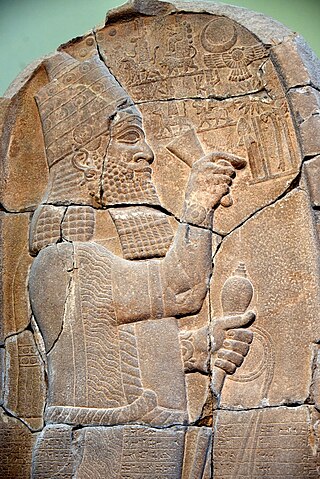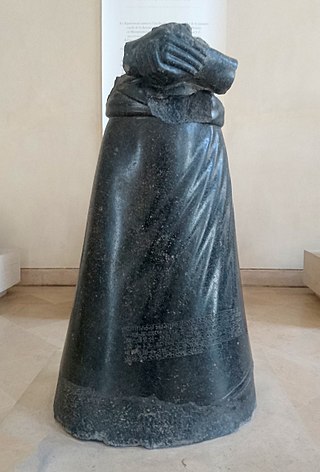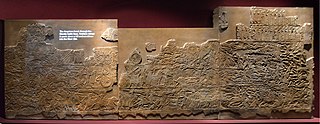
Babylonia was an ancient Akkadian-speaking state and cultural area based in the city of Babylon in central-southern Mesopotamia. It emerged as an Akkadian populated but Amorite-ruled state c. 1894 BC. During the reign of Hammurabi and afterwards, Babylonia was retrospectively called "the country of Akkad", a deliberate archaism in reference to the previous glory of the Akkadian Empire. It was often involved in rivalry with the older ethno-linguistically related state of Assyria in the north of Mesopotamia and Elam to the east in Ancient Iran. Babylonia briefly became the major power in the region after Hammurabi created a short-lived empire, succeeding the earlier Akkadian Empire, Third Dynasty of Ur, and Old Assyrian Empire. The Babylonian Empire rapidly fell apart after the death of Hammurabi and reverted to a small kingdom centered around the city of Babylon.

Susa was an ancient city in the lower Zagros Mountains about 250 km (160 mi) east of the Tigris, between the Karkheh and Dez Rivers in modern day Iran. One of the most important cities of the Ancient Near East, Susa served as the capital of Elam and the winter capital of Achaemenid Empire, and remained a strategic centre during the Parthian and Sasanian periods.

Esarhaddon, also spelled Essarhaddon, Assarhaddon and Ashurhaddon was the king of the Neo-Assyrian Empire from the death of his father Sennacherib in 681 BC to his own death in 669. The third king of the Sargonid dynasty, Esarhaddon is most famous for his conquest of Egypt in 671 BC, which made his empire the largest the world had ever seen, and for his reconstruction of Babylon, which had been destroyed by his father.

Elam was an ancient civilization centered in the far west and southwest of modern-day Iran, stretching from the lowlands of what is now Khuzestan and Ilam Province as well as a small part of southern Iraq. The modern name Elam stems from the Sumerian transliteration elam(a), along with the later Akkadian elamtu, and the Elamite haltamti. Elamite states were among the leading political forces of the Ancient Near East. In classical literature, Elam was also known as Susiana, a name derived from its capital Susa.

Chedorlaomer, also spelled Kedorlaomer, is a king of Elam mentioned in Genesis 14. Genesis portrays him as allied with three other kings, campaigning against five Canaanite city-states in response to an uprising in the days of Abraham.

Ashurbanipal was the king of the Neo-Assyrian Empire from 669 BC to his death in 631. He is generally remembered as the last great king of Assyria. Ashurbanipal inherited the throne as the favored heir of his father Esarhaddon; his 38-year reign was among the longest of any Assyrian king. Though sometimes regarded as the apogee of ancient Assyria, his reign also marked the last time Assyrian armies waged war throughout the ancient Near East and the beginning of the end of Assyrian dominion over the region.

Manishtushu (Man-ištušu) c. 2270-2255 BC was the third king of the Akkadian Empire, reigning 15 years from c. 2270 BC until his death in c. 2255 BC. His name means "Who is with him?". He was the son of Sargon the Great, the founder of the Akkadian Empire, and he was succeeded by his son, Naram-Sin who also deified him posthumously. A cylinder seal, of unknown provenance, clearly from the reign of Naram-Sin or later, refers to the deified Manishtushu i.e. "(For) the divine Man-istusu: Taribu, the wife of Lugal-ezen, had fashioned". Texts from the later Ur III period show offerings to the deified Manishtushu. The same texts mention a town of ᵈMa-an-iš-ti₂-su where there was a temple of Manishtushu. This temple was known in the Sargonic period as Ma-an-iš-t[i-s]uki.

Pinikir, also known as Pinigir, Pirengir, Pirinkir, and Parakaras, was an Ancient Near Eastern astral goddess who originates in Elamite religious beliefs. While she is only infrequently attested in Elamite documents, she achieved a degree of prominence in Hurrian religion. Due to her presence in pantheons of many parts of the Ancient Near East, from Anatolia to Iran, modern researchers refer to her as a "cosmopolitan deity."

Nebuchadnezzar I, reigned c. 1121–1100 BC, was the fourth king of the Second Dynasty of Isin and Fourth Dynasty of Babylon. He ruled for 22 years according to the Babylonian King List C, and was the most prominent monarch of this dynasty. He is best known for his victory over Elam and the recovery of the cultic idol of Marduk.

Untash-Napirisha was king of Elam during the Middle Elamite period, circa 1300 BCE. He was the son of the previous Elamite king, Humban-Numena and of a daughter of Kurigalzu. He was named after Napirisha, an Elamite deity.

The Battle of Nineveh is conventionally dated between 613 and 611 BC, with 612 BC being the most supported date. Rebelling against the Assyrians, an allied army which combined the forces of Medes and the Babylonians besieged Nineveh and sacked 750 hectares of what was, at that time, one of the greatest cities in the world. The fall of Nineveh led to the destruction of the Neo-Assyrian Empire over the next three years as the dominant state in the Ancient Near East. Archeological records show that the capital of the once mighty Assyrian Empire was extensively de-urbanized and depopulated in the decades and centuries following the battle. A garbled account of the fall of the city later led to the story of the legendary king Sardanapalus.

The Battle of the Ulai River, also known as the Battle of Til-Tuba or the Battle of Tulliz, in c. 653 BCE, was a battle between the invading Assyrians, under their king Ashurbanipal, and the kingdom of Elam, which was a Babylonian ally. The result was a decisive Assyrian victory. Teumman, the king of Elam, and his son Tammaritu were killed in the battle.

The Neo-Assyrian Empire arose in the 10th century BC. Ashurnasirpal II is credited for utilizing sound strategy in his wars of conquest. While aiming to secure defensible frontiers, he would launch raids further inland against his opponents as a means of securing economic benefit, as he did when campaigning in the Levant. The result meant that the economic prosperity of the region would fuel the Assyrian war machine.
The Battle of Halule took place in 691 BC between the Assyrian empire and the rebelling forces of the Babylonians, Chaldeans, Persians, Medes, Elamites and Aramaic tribes.

The conquest of Elam by the Neo-Assyrian Empire took place between 655 and 639 BC.

The Sargonid dynasty was the final ruling dynasty of Assyria, ruling as kings of Assyria during the Neo-Assyrian Empire for just over a century from the ascent of Sargon II in 722 BC to the fall of Assyria in 609 BC. Although Assyria would ultimately fall during their rule, the Sargonid dynasty ruled the country during the apex of its power and Sargon II's three immediate successors Sennacherib, Esarhaddon and Ashurbanipal are generally regarded as three of the greatest Assyrian monarchs. Though the dynasty encompasses seven Assyrian kings, two vassal kings in Babylonia and numerous princes and princesses, the term Sargonids is sometimes used solely for Sennacherib, Esarhaddon and Ashurbanipal.

Humban-haltash III or Umanaldash was the last major ruler of Elam. He was defeated and captured by the Assyrian king Ashurbanipal.

The Sukkalmah Dynasty, also Epartid Dynasty after the founder Eparti/Ebarat, was an early dynasty of West Asia in the ancient region of Elam, to the southeast of Babylonia. It corresponds to the latest part of the Old Elamite period.

Tammaritu I, son of Urtak, was briefly a ruler in the ancient kingdom of Elam, ruling after the beheading of his predecessor Teumman in 653. He ruled part of Elam while his brother, Ummanigash, ruled another.


















